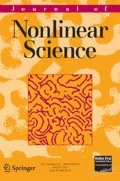Summary
We present a framework for analysing arbitrary networks of identical dissipative oscillators assuming weak coupling. Using the symmetry of the network, we find dynamically invariant regions in the phase space existing purely by virtue of their spatio-temporal symmetry (the temporal symmetry corresponds to phase shifts). We focus on arrays which are symmetric under all permutations of the oscillators (this arises with global coupling) and also on rings of oscillators with both directed and bidirectional coupling. For these examples, we classify all spatio-temporal symmetries, including limit cycle solutions such as in-phase oscillation and those involving phase shifts. We also show the existence of “submaximal” limit cycle solutions under generic conditions. The canonical invariant region of the phase space is defined and used to investigate the dynamics. We discuss how the limit cycles lose and gain stability, and how symmetry can give rise to structurally stable heteroclinic cycles, a phenomenon not generically found in systems without symmetry. We also investigate how certain types of coupling (including linear coupling between oscillators with symmetric waveforms) can give rise to degenerate behaviour, where the oscillators decouple into smaller groups.
Similar content being viewed by others
References
J. C. Alexander and G. Auchmuty. Global bifurcations of phase-locked oscillators.Arch. Rat. Mech. Anal., 93:253–270, 1986.
J. C. Alexander and B. Fiedler. Global bifurcations of coupled symmetric oscillators. In Ladas, Dafermos and Papanicolaou, editors,Proceedings of the Equadiff Conference, volume 118 ofLecture Notes in Pure and Applied Mathematics (Differential Equations), pages 7–26. AMS, Providence, RI, 1987.
A. A. Andronov, A. A. Vitt, and S. E. Chaikin.Theory of oscillators. Pergamon, Oxford, 1966.
D. G. Aronson, E. J. Doedel, and H. G. Othmer. The dynamics of coupled current-biased Josephson junctions—part ii.International Journal of Bifurcation and Chaos, 1:51–66, 1991.
D. G. Aronson, M. Golubitsky, and M. Krupa. Coupled arrays of Josephson junctions and bifurcations of maps with S(n) symmetry.Nonlinearity, 4:8 G1–902 (1991).
P. Ashwin, G. P. King, and J. W. Swift. Three identical oscillators with symmetric coupling.Nonlinearity, 3:585–603, 1990.
C. Baesens, J. Guckenheimer, S. Kim, and R. S. MacKay. Three coupled oscillators: mode-locking, global bifurcations and toroidal chaos.Physica D, 24:387–475, 1991.
E. J. Doedel, D. G. Aronson, and H. G. Othmer. The dynamics of coupled current-biased Josephson junctions: part 1.IEEE CAS, 35:810–817, 1988.
T. Endo and S. Mori. Mode analysis of a ring of a large number of mutually coupled van der pol oscillators.IEEE CAS, 25:7–18, 1978.
G. B. Ermentrout. The behavior of rings of coupled oscillators.J. Math. Biol., 23:55–74, 1985.
G. B. Ermentrout and N. Kopell. Frequency plateaus in a chain of weakly coupled oscillators.SIAM J. Math. Anal., 15:215–237, 1984.
B. Fiedler,Global bifurcations of periodic solutions with symmetry, volume 1309 ofSpringer lecture notes in mathematics. Springer, Berlin, 1988.
M. J. Field and R. W. Richardson. Symmetry breaking and the maximal isotropy subgroup conjecture for reflection groups.Arch. Rat. Mech. Anal., 105:61–94, 1989.
M. Golubitsky and I. N. Stewart. Hopf bifurcation in the presence of symmetry.Arch. Rat. Mech. Anal., 87:107–165, 1985.
M. Golubitsky and I. N. Stewart. Hopf bifurcation with dihedral group symmetry. InMultiparameter bifurcation theory, volume 56 ofContemporary Maths, pages 131–173. AMS, Providence, RI, 1985.
M. Golubitsky, I. N. Stewart, and D. Schaeffer.Groups and singularities in bifurcation theory, volume 2. App. Math. Sci. 69. Springer, New York, 1988.
J. Grasman and M. J. W. Jansen. Mutually synchronised relaxation oscillators as prototypes of oscillating systems in biology.J. Math. Biol., 7:171–197, 1988.
J. Guckenheimer and P. Holmes.Nonlinear oscillations, dynamical systems and bifurcations of vector fields. App. Math. Sci. 42. Springer, New York, 1983.
P. Hadley.Dynamics of Josephson junction arrays. Ph.D. thesis, Dept. of Applied Physics, Stanford University, 1989.
P. Hadley, M. R. Beasley, and K. Wisenfeld. Phase locking of Josephson junction series arrays.Phys. Rev. B, 38:8712–8719, 1988.
C. Hayashi.Nonlinear oscillations in physical systems. McGraw Hill, 1964. Reprinted 1985 by Princeton University Press.
M. Hirsch, C. Pugh, and M. Shub.Invariant manifolds. LNM 583. Springer, Berlin, 1977.
N. Kopell and G. B. Ermentrout. Symmetry and phase locking in chains of weakly coupled oscillators.Comm. Pure App. Math., 39:623–660, 1986.
D. Linkens. Nonlinear circuit mode analysis.IEEE Proc., 130A:69–87, 1983.
J. D. Murray.Mathematical biology, Biomathematics, 13. Springer, Berlin, 1989.
H. G. Othmer and L. E. Scriven. Instability and dynamic pattern formation in cellular networks.J. Theor. Biology, 32:507–537, 1971.
J. A. Sanders and F. Verhulst.Averaging methods in nonlinear dynamical systems. App. Math. Sci. 59. Springer, New York, 1985.
J. W. Swift. Hopf bifurcation with the symmetry of the square.Nonlinearity, 1:333–377, 1988.
J. W. Swift, S. H. Strogatz, and K. Wiesenfeld. Averaging of globally coupled oscillators. Preprint, NAU, 1991.
K. Y. Tsang, R. E. Mirollo, S. H. Strogatz, and K. Wiesenfeld. Slow dynamics in a globally coupled oscillator array. Submitted toPhysica D, 1990.
K. Y. Tsang and I. B. Schwartz. Interhyperhedral diffusion in Josephson junction arrays. Preprint, 1991.
A. M. Turing. The chemical basis of morphogenesis.Phil. Trans. Roy. Soc. Lond. B, 237:37–72, 1952.
B. van der Pol. On relaxation oscillations.Phil. Mag., 7–2:978–992, 1926.
B. van der Pol. Forced oscillations in a circuit with nonlinear resistance.Phil. Mag., 7–3:18–38, 1927.
K. Wiesenfeld and P. Hadley. Attractor crowding in oscillator arrays.Phys. Rev. Lett., 62:1335–1338, 1988.
S. Wiggins.Global bifurcations and chaos. App. Math. Sci. 73. Springer, New York, 1988.
A. T. Winfree. Biological rhythms and the behaviour of populations of coupled oscillators.Theoretical Biology, 16:15–42, 1967.
Author information
Authors and Affiliations
Additional information
Communicated by Jerrold Marsden
Rights and permissions
About this article
Cite this article
Ashwin, P., Swift, J.W. The dynamics ofn weakly coupled identical oscillators. J Nonlinear Sci 2, 69–108 (1992). https://doi.org/10.1007/BF02429852
Received:
Accepted:
Issue Date:
DOI: https://doi.org/10.1007/BF02429852




